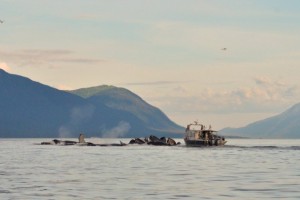
Is the North Pacific humpback whale no longer endangered? The National Oceanic and Atmospheric Administration could decide as early as today whether to pursue taking the whale off the Endangered Species list.
A group of Hawaiian fishermen submitted a petition to de-list humpbacks in April and the agency will determine if it has enough credible information for further review.
Removing the North Pacific humpback from the Endangered Species list would require NOAA to revisit an important regulation specific to watching humpback whales in Alaska waters.
The rapid growth of Juneau’s whale watching industry may be causing some vessels to overlook regulations and guidelines.
“There’s probably eight to ten whales that I can just look at and say, ‘That’s Willy,’ or, ‘That’s Sasha,’ or, ‘That’s Sheila,’ or ‘That’s Monty.’ Flame is out here, you can recognize her very quickly. Spot’s out here, so we recognize her,” explains Larry Dupler, better known as Captain Larry. Dupler started conducting whale watching trips with Dolphin Tours in 1994, back when there were only a handful of local companies on the water.
“Sasha has a scar across her back and down her right side, and on her backside of her tail, she’s got the initials AK on the bottom left fluke,” he says.
Dupler helped start Orca Enterprises in 1997 and has been with the company ever since.
“Some of these whales I know and I know they know me, almost have a personal relationship with some of them.”
But, he says, not all captains feel the same way.
“If you watch the way some of the captains handle their boats around the animals, they’re not worried about the animal itself. They’re more worried about their customers and making them happy, getting them a good show, and some of them even violate the guidelines and regulations that we have in place.”
By 2001 it was clear to NOAA that humpbacks in Alaska were particularly vulnerable to pressure and potential harm from increased vessel traffic and whale watching. The Protected Resources Division came up with the “hundred yard rule” making it unlawful to approach within 100 yards of a humpback whale in Alaska waters.
While establishing the regulation, NOAA considered a permitting system for the whale watching industry, but concluded it didn’t have sufficient infrastructure.
No permitting system exists for vessels that want to enter the industry.
Weather Permitting owner and captain Greg Brown says whale watching should be more tightly regulated, “There is a lot of abuse and a lot of whales getting run over and pressured. That can be avoided if we changed the rules a little bit.”
NOAA’s Enforcement Division received 42 reports of harassment to humpbacks statewide in 2012. While the agency has patrol boats, including one in the greater Juneau area, most complaints come from the general public.
“We really encourage everyone to consider themselves a steward of this animal,” says Marine mammal specialist Aleria Jensen.
Humpbacks are in Alaska May through September, and most spend the rest of the year in Hawaii. “Alaska is the kitchen. It’s completely the time for foraging, for feeding, for bulking up,” explains Jensen.
She says regulations and guidelines are meant to limit disturbance to the whales’ natural behavior.
Gauging a hundred-yard distance for whale watching requires training. Allen Marine Tours, for example, has a range finder on every boat, according to Juneau general manager Eric Majeski.
“In the training week, we’ll go out to an island or a reef, somewhere where we can have a hard surface to get a digital read from, and have all the captains stand at the helm and see how far away that is. They can use every tool they can to make sure they’re staying at least a hundred yards away,” says Mejeski.
Allen Marine started offering whale watching tours in 1995. “We started off with just three boats and now we’re up to 13 boats based in Juneau.”
NOAA Enforcement Division special agent Ron Antaya says the number of humpback harassment complaints has not varied over the years despite the growing number of tour boats. He believes the industry polices itself.
“Given the volume of tour activity out there and the volume of complaints we get, I think that speaks for itself. They’re doing a pretty good job.”
Last month, NOAA fined Alaska Yacht Charters $5,000 for coming within 30 feet of a pod of breaching whales in 2010. The company’s owner Geoffrey Wilson was found liable under theMarine Mammal Protection Act and the Endangered Species Act.
NOAA will look at abundance trends as it considers the petition to de-list. Alaska Fisheries Science Center director Doug DeMaster says the number of North Pacific humpback whales has increased, “We went from what may have been as few as a thousand or so animals in the 1960s to more than 20,000 humpback whales today.”
Orca Enterprises Dupler worries the industry has grown past the point of saturation.
“Today there’s like three or four humpbacks in the general area and it’s not uncommon now to go out and see 15 to twenty-some boats sitting around one animal.”
The Alaska Visitor Statistics Program indicates more than 50 percent of visitors engage in wildlife viewing, including whale watching, making it one of the most popular tourist activities in the state.
Lisa Phu is a reporter at KTOO in Juneau.




